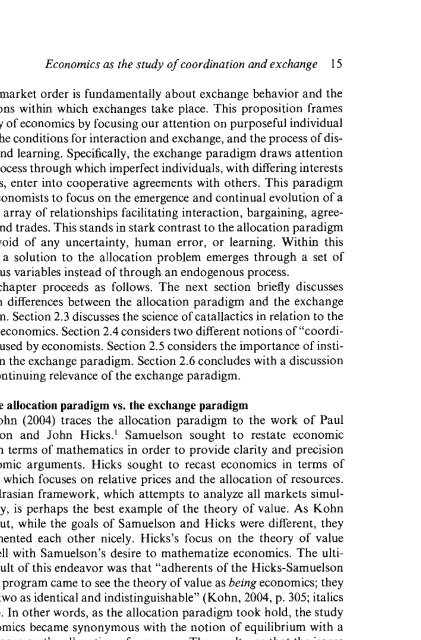Handbook on Contemporary Austrian Economics
Handbook on Contemporary Austrian Economics
Handbook on Contemporary Austrian Economics
Create successful ePaper yourself
Turn your PDF publications into a flip-book with our unique Google optimized e-Paper software.
Ec<strong>on</strong>omics as the study of coordinati<strong>on</strong> and exchange 15<br />
and the market order is fundamentally about exchange behavior and the<br />
instituti<strong>on</strong>s within which exchanges take place. This propositi<strong>on</strong> frames<br />
the study of ec<strong>on</strong>omics by focusing our attenti<strong>on</strong> <strong>on</strong> purposeful individual<br />
acti<strong>on</strong>, the c<strong>on</strong>diti<strong>on</strong>s for interacti<strong>on</strong> and exchange, and the process of discovery<br />
and learning. Specifically, the exchange paradigm draws attenti<strong>on</strong><br />
to the process through which imperfect individuals, with differing interests<br />
and ends, enter into cooperative agreements with others. This paradigm<br />
forces ec<strong>on</strong>omists to focus <strong>on</strong> the emergence and c<strong>on</strong>tinual evoluti<strong>on</strong> of a<br />
complex array of relati<strong>on</strong>ships facilitating interacti<strong>on</strong>, bargaining, agreements,<br />
and trades. This stands in stark c<strong>on</strong>trast to the allocati<strong>on</strong> paradigm<br />
that is void of any uncertainty, human error, or learning. Within this<br />
c<strong>on</strong>text, a soluti<strong>on</strong> to the allocati<strong>on</strong> problem emerges through a set of<br />
exogenous variables instead of through an endogenous process.<br />
This chapter proceeds as follows. The next secti<strong>on</strong> briefly discusses<br />
the main differences between the allocati<strong>on</strong> paradigm and the exchange<br />
paradigm. Secti<strong>on</strong> 2.3 discusses the science of catallactics in relati<strong>on</strong> to the<br />
study of ec<strong>on</strong>omics. Secti<strong>on</strong> 2.4 c<strong>on</strong>siders two different noti<strong>on</strong>s of "coordinati<strong>on</strong>"<br />
used by ec<strong>on</strong>omists. Secti<strong>on</strong> 2.5 c<strong>on</strong>siders the importance of instituti<strong>on</strong>s<br />
in the exchange paradigm. Secti<strong>on</strong> 2.6 c<strong>on</strong>cludes with a discussi<strong>on</strong><br />
of the c<strong>on</strong>tinuing relevance of the exchange paradigm.<br />
2.2 The aUocati<strong>on</strong> paradigm vs. the exchange paradigm<br />
Meir Kohn (2004) traces the allocati<strong>on</strong> paradigm to the work of Paul<br />
Samuels<strong>on</strong> and John Hicks.l Samuels<strong>on</strong> sought to restate ec<strong>on</strong>omic<br />
theory in terms of mathematics in order to provide clarity and precisi<strong>on</strong><br />
in ec<strong>on</strong>omic arguments. Hicks sought to recast ec<strong>on</strong>omics in terms of<br />
"value," which focuses <strong>on</strong> relative prices and the allocati<strong>on</strong> of resources.<br />
The Walrasian framework, which attempts to analyze all markets simultaneously,<br />
is perhaps the best example of the theory of value. As Kohn<br />
points out, while the goals of Samuels<strong>on</strong> and Hicks were different, they<br />
complemented each other nicely. Hicks's focus <strong>on</strong> the theory of value<br />
fitted well with Samuels<strong>on</strong>'s desire to mathematize ec<strong>on</strong>omics. The ultimate<br />
result of this endeavor was that "adherents of the Hicks-Samuels<strong>on</strong><br />
research program came to see the theory of value as being ec<strong>on</strong>omics; they<br />
saw the two as identical and indistinguishable" (Kohn, 2004, p. 305; italics<br />
original). In other words, as the allocati<strong>on</strong> paradigm took hold, the study<br />
of ec<strong>on</strong>omics became syn<strong>on</strong>ymous with the noti<strong>on</strong> of equilibrium with a<br />
central focus <strong>on</strong> the allocati<strong>on</strong> of resources. The result was that the issues<br />
of exchange, instituti<strong>on</strong>s, and the process of coordinati<strong>on</strong> were pushed by<br />
the wayside.<br />
For purposes of clarity, it makes sense to review the key similarity,<br />
as well as the main difference, between the allocati<strong>on</strong> paradigm and the

















